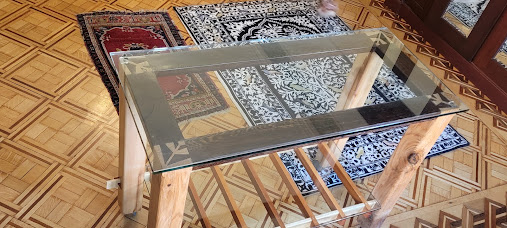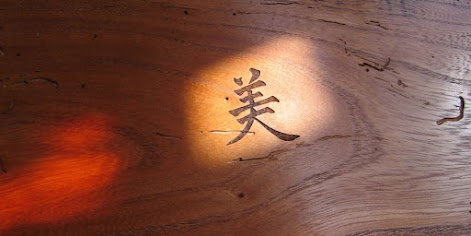Kakushi Ari Kata Sanmai Hozo Joint
By Robert Kroll
Hanging art in a small apartment, with few
walls that don’t have doors and windows can be a problem. What if your
furniture, your dining table, buffet or cupboards were created so that art
could be displayed from them?
That was the task I set myself to in my Dumbo
design studio. By chance, I happened upon an article about an obscure Japanese
wooden joint, known as the Kakushi Ari Kata Sanmai Hozo joint, that set off
light bulbs in my head and sent me to the drawing board,
The joint can be described as a mitred
dovetail that is used at the corner of a table or cabinet to join two timbers
at right angles. If you were to lace your fingers together at the knuckles,
palms down, then twist your hands slightly toward each other, you’ll get the
general idea.
Like so much in the world of Japanese joinery
and woodworking, this joint is self-sustaining, meaning it holds itself
together without metal fasteners or potentially without any adhesive.
In the drawing the dark areas are the ends of
horizontal support/beam at the top of a table. The light areas are the end
grain on the top of each of the table legs at the corner. The joint is made
like an inlay, i.e., a picture, and the inlay is half an inch thick. This is an
extremely strong joint in every plane. It can’t be twisted in any direction.
The legs and top of the table become like one.
Theoretically, a high-rise building could be
put together with a steel frame and this type of joinery instead of rivets and
bolts.
What’s the point of this type of joinery and
what are its virtues, its opportunities, and its meaning in the greater scheme
of things?
In Western style table design, the slab top
is actually a part of the structure of the table and gives it sheer strength.
Anyone who has had a table that has gotten weak or collapsed at the joints and
had to be re-glued, screwed together with thick steel straps and still have a
wobbly table will understand. This table is one and done. Absent abuse, it will
last several lifetimes and can be passed through generations. Anyone who has
purchased an oak or mahogany table from an antique shop, or, God forbid, an
Ikea mass produced table from Thailand, expects to get a couple of good years
use out of it before putting it out on the sidewalk for recycling.
But the more important feature of this
structural method is that it creates an extremely strong “picture frame” at the
top. Artwork, especially photos, can be inserted in the frame and the whole
table covered with a thick (1/2”) sheet of glass. Now you are displaying your
art collection in a way and in a place that in the normal course of life would
be covered with place mats and condiments.
The artwork could be an oil painting, a
watercolor, any two-or-three-dimensional piece or even one that is backlit from
below by a light box. Among the endless possibilities for framing art in a
tabletop are selfies; photos of one’s grandchildren or grandparents; a Torah
scroll parchment from your bar mitzvah, or anything you might want to view
during a meal to calm the nerves after a hard day’s work.
Mark my words: you will never, or long
remember, the phrase Kakushi Ari kata san mai hozo. Don’t even think about
Googling it.
Robert Kroll is a woodworker, Co-op Super,
retired lawyer and legal journalist. Copyright May, 2022.


%20(1).jpg)
Comments
Post a Comment